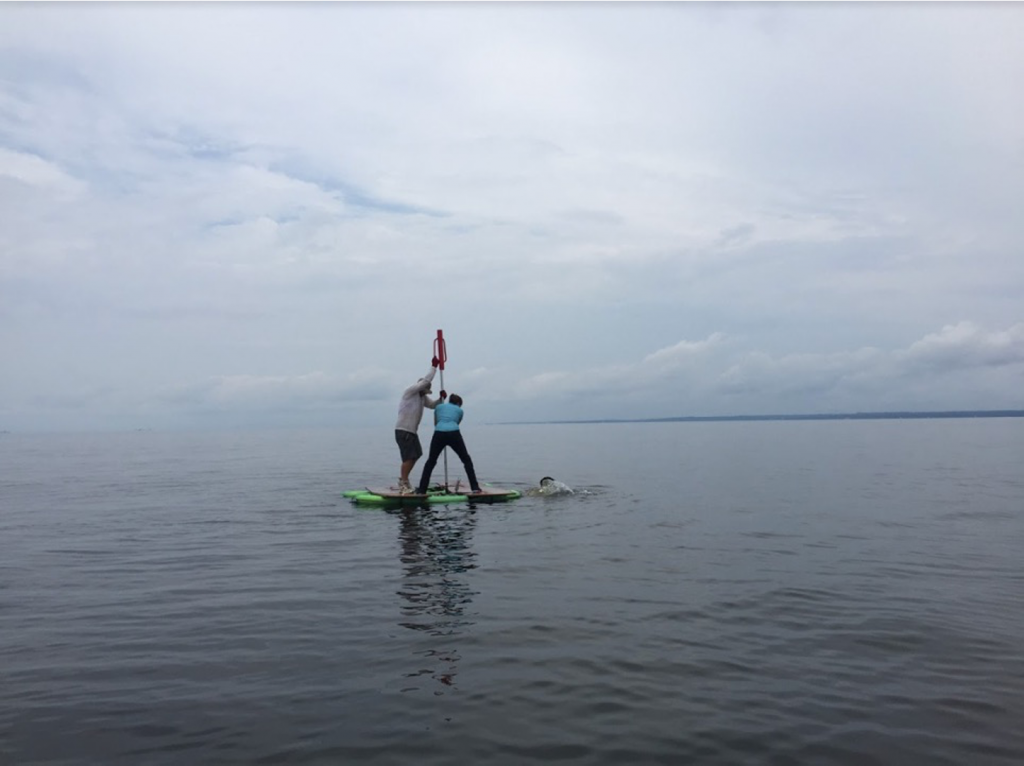Rebecca L. Totten
Associate Professor
Education
- PhD, Earth Science, Rice University, 2015
- Shell Exploration and Production Co, 2015–2016
- BS, Geology and Geophysics, University of Kansas, 2009
- Geology and Geophysics, University of New Orleans, 2004–2005
Research Areas
- Marine Geology and Geophysics
- Paleontology, Paleoclimatology, and Paleoecology
- Energy
Labs
About
Research
My research is driven by the impacts of recent climate change; I strive to better understand historic observations within a geologic context. My primary field area is in marine basins of Antarctica, where I reconstruct the behavior of tidewater glaciers, ice shelves, and ice streams from sediment cores, microfossils, isotopes, and geophysical data. Analyzing regional differences in glacial behavior will help elucidate controls on their stability, including internal glacial dynamics, drainage basin size, orography, oceanography, and climate. Understanding these controls can help us better predict glacial responses to ongoing climate and oceanographic changes.
I am also interested in flooding history and storm impacts in the Gulf of Mexico region, and specifically how climate and land-use changes affect coastal environments. Sedimentology, algal bloom records, and geochemical signatures of sediment cores collected from estuaries are used to reconstruct Holocene storm and flooding history.
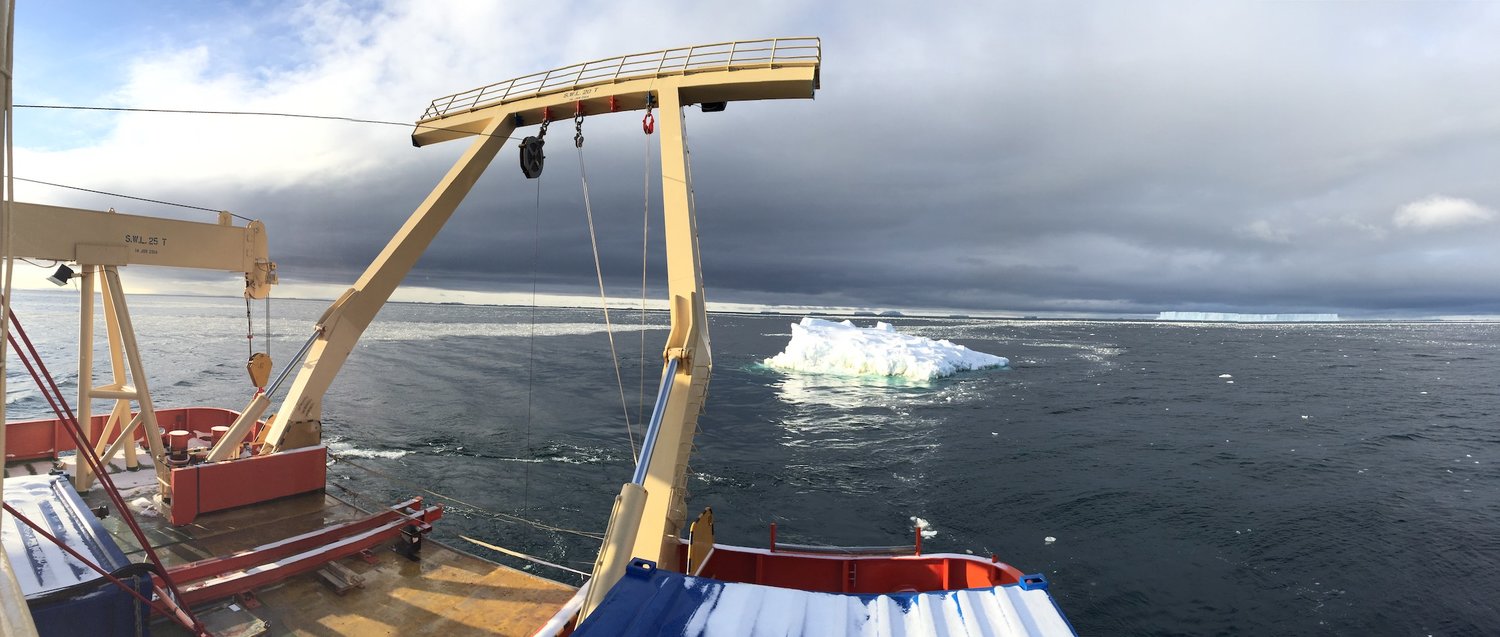
Current Research Projects
NSF THOR Project: We are funded by NSF and NERC to study the past and present stability of Thwaites Glacier, Antarctica, which is rapidly receding and has significant potential to contribute to sea-level rise. Our Thwaites Offshore Research team (THOR) of the International Thwaites Glacier Collaboration has collected sediment and geophysical records through two research expeditions and is currently analyzing these data to elucidate drivers of recent changes in the Thwaites Glacier system, as well as changes over the last 10,000 years. University of Alabama’s role in this research involves ocean productivity and temperature reconstructions. We analyze microscopic fossils of diatom and foraminifera plankton populations, as well as stable isotopes, to reconstruct ice-shelf history, sea-ice concentration, and the influence of warm deepwater through time.
Students on the project: Trudie Murphy (Geology major, Evolutionary Studies minor, Outstanding Rising Senior in Geological Sciences); Gabi Barnes (UA Emerging Scholar, Geology major); Asmara Lehrmann (completed 2022, NSF Graduate Research Fellow and UA Graduate Council Fellow); Emma Tegert (BS Geology 2022, Outstanding Rising Junior & Senior in Geological Sciences); Robert Michael Comas (BS Environmental Science 2020, now a MS student at University of Houston on the project); Victoria Fitzgerald (completed 2020, NSF Graduate Research Fellow). Student on related project on Antarctic Peninsula glaciers: Adlai N.R. Fonseca (MS Geology, 2019).
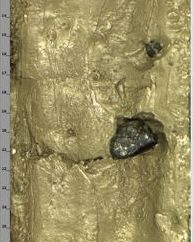
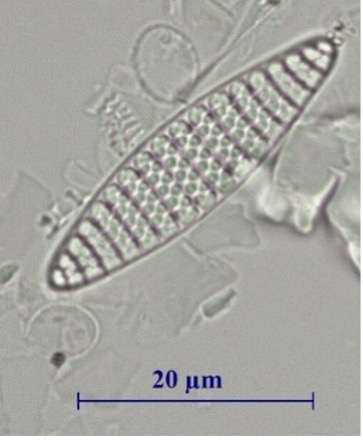
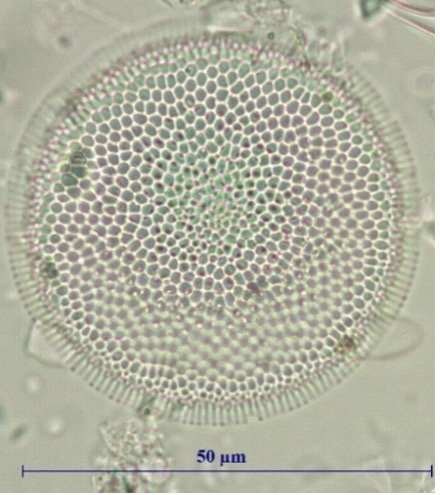
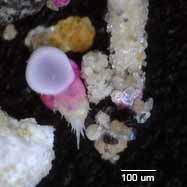
Example of a dropstone offshore Antarctica. Oceanographic influence on glacier stability can be interpreted from microfossils preserved in the sediment layers, including offshore diatoms (like the ~20 micron Fragilariopsis kerguelensis shown in the middle), while temperature of the water can be interpreted from warm-affinity diatoms, like the circular Thalassiosira antarctica- warm variety shown here, as well as benthic foraminifera like Bulumina aculeata, shown here with pink staining the living tissues. Credit- A.N.R. Fonseca and R.L. Totten.
BOEM Microfossils Project: We are also funded by the Bureau of Ocean Energy Management – Marine Minerals Program to reconstruct paleo-environments and Pleistocene-Holocene coastal evolution offshore Mississippi through microfossil assemblage analysis, in support of the University of Southern Mississippi Cooperative Agreement (PI Davin Wallace) to map and quantify offshore sediment resources. We are currently analyzing ~40 cores with USM across the paleo-valley system offshore Petit Bois and Horn Islands, with planned seismic acquisition this summer.
Students on the project: Gabi Barnes (UA Emerging Scholar, Geology major), Jacob Helgeson (Marine Science Biology major), Jazmin Simons (BS Environmental Science, 2023), Elizabeth Favor (BS Marine Science Biology, 2023), Maddie Cherry (BS Marine Science Biology, 2022), and Jess Meyer (BS Marine Science Biology, 2022)
Paleo-reconstructions to improve coastal resiliency of Alabama and Mississippi: Ongoing work in the Mobile Bay-Mississippi Sound system is targeted at reconstructing paleo-storm and flood frequencies throughout the Holocene. With limited instrumental records and large paleoclimate data gaps in the Southeastern US, we aim to improve our knowledge of climate and storm relationships through long records, as well as quantify the impact of storms and coupled human impacts on ecology of estuaries. In collaboration with Drs. Davin Wallace (USM), Emily Elliott (UA), Fred Andrus (UA), Joe Lambert (UA), and other CoRPS faculty.
Students on the project: Lauren Parker (graduated, MS 2019, National Alumni Association Fellow, now working for environmental company in Maryland); Joel Sobrado (BS 2020, U.S. Army ret., now working for environmental geology company in Arizona).
USGS EdMap Project: We have also been funded by the U.S. Geological Survey to map the Coatopa Quadrangle of the Gulf Coastal Plain, in a location with world-famous outcrops of the Cretaceous-Paleogene boundary. We work closely with the Geological Survey of Alabama Groundwater Division to map, measure stratigraphic sections, provide biostratigraphic zonations, and measure permeability that will help in building a groundwater model for the Tombigbee River system.
Student on the project: Tyler Wood (3rd year MS student, former AAPG Chapter Vice President).
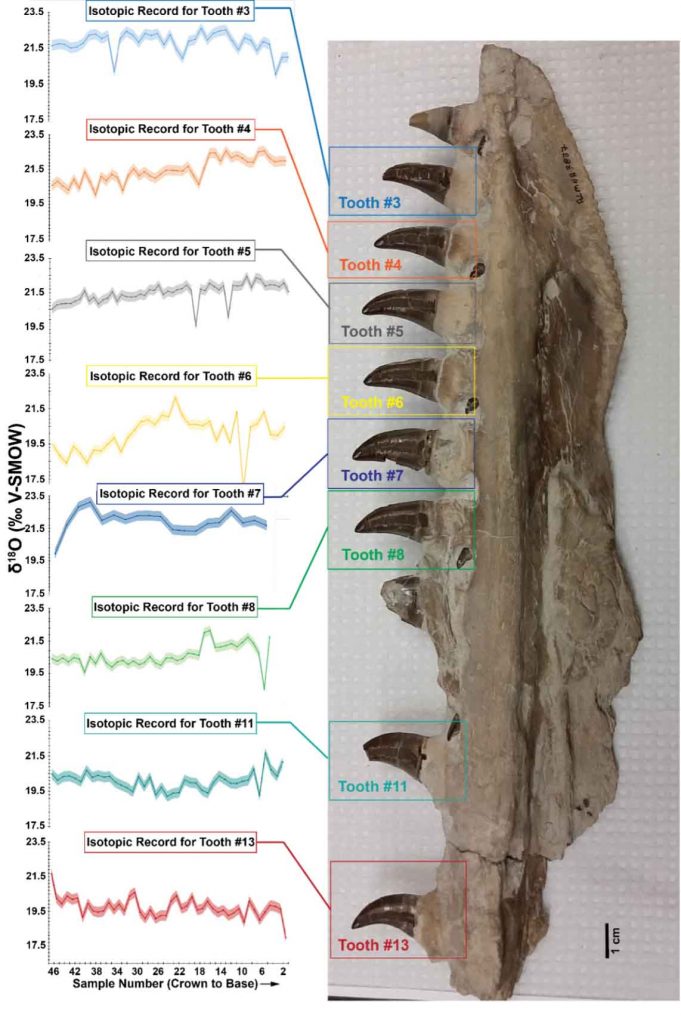
Fossil Marine Reptile Paleo-ecology: We analyze oxygen isotopes from fossil teeth to reconstruct the water environments that ancient marine mosasaurs inhabited. Continuous records of daily growth lines allow us to reconstruct their migration history and paleo-biology. In collaboration with Drs. Celina Suarez (UArk), Luis Gonzalez (KU), Dana Ehret (NJ State Museum), Lynn Harrell (Geological Survey of Alabama), and the Alabama Museum of Natural History.
Student on the project: Leah Travis Taylor (MS 2019, McNair Fellow, UA Graduate Council Fellow, now pursuing a PhD in paleoclimatology at UMass-Amherst).
I am always searching for motivated students of sedimentology, micropaleontology, and stable isotope geochemistry to investigate some of our most pressing questions about the environmental and ecological impacts of past and present climate change. Contact me if this is you!
To learn more about what this research looks like, please visit our UA Sedimentary Geology and Micropaleontology laboratory website (microfossils.as.ua.edu).
Research Affiliations
- Center for Sedimentary Basin Studies
- Alabama Stable Isotope Laboratory
- Collaborative Research on Paleoenvironments and Societies
- Evolutionary Studies
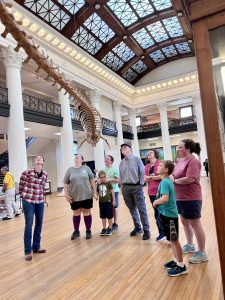
Selected Publications
Google Scholar Profile; Research Gate Profile
*student of Totten
Where underlined, the publication name has been updated to R.L. Totten.
Clark, R.W., Wellner, J.S., Hillenbrand, C.-D., Totten, R.L., Smith, J.A., Simkins, L.M., Larter, R.D., Hogan, K.A., Graham, A.G.C., Nitsche, F.O., Lehrmann, A.A.*, Lepp, A.P., Kirkham, J.D., Fitzgerald, V.T.*, Garcia-Barrera, G., Ehrmann, W., and Wacker, L., in press in the Proceedings of the National Academy of Science, Synchronous retreat of Thwaites and Pine Island glaciers in response to external forcings in the pre-satellite era. (IF 11.205, Q1)
Graham, A.G., Wahlin, A., Hogan, K.A., Nitsche, F.O., Heywood, K.J., Totten, R.L., Smith, J.A., Hillenbrand, C-D., Simkins, L., Wellner, J.S., and Larter, R.D., 2022. Rapid tidally-modulated retreat of Thwaites Glacier from a pinning point in the pre-satellite era, Nature Geoscience. https://doi.org/10.1038/s41561-022-01019-9 (IF 15.781, Q1)
Lepp, A.P., Simkins L.M., Anderson, J.B., R.W. Clark, R.W., Wellner, J.S., Hillenbrand, C-D., Smith, J.A., Lehrmann, A.A.*, Totten, R., Larter, R.D., Hogan, K.A., Nitsche, F.O., and Graham, A.G.C., and Wacker, L., 2022. Spatiotemporal variability in meltwater drainage from Thwaites Glacier, Antarctica, v. 10, 2296-6463, Frontiers in Earth Science. https://doi.org/10.3389/feart.2022.863200 (IF 3.229, Q1)
Sproson, A.D., Yokoyama, Y., Miyairi, Y., Aze, T., and Totten, R.L., 2022. Holocene melting of the West Antarctic Ice Sheet driven by tropical Pacific warming, Nature Communications, v. 13, 2434. https://doi.org/10.1038/s41467-022-30076-2 (IF 14.92, Q1)
Totten, R.L., Fonseca, A.N.R.*, Wellner, J.S., Munoz, Y.P., Anderson, J.B., and Tobin, T., 2022. Oceanographic and Climatic Influences on Trooz Glacier, Antarctica during the Holocene, Quaternary Science Reviews, v. 276, 107279. https://doi.org/10.1016/j.quascirev.2021.107279 (IF 4.878, Q1)
Taylor, L.T.*, Totten, R.L., Suarez, C.A., Gonzalez, L.A., Martin, L.D., Lambert, W.J., Ehret, D.J., and Harrell, T.L., 2021. Oxygen isotopes from the teeth of Cretaceous marine lizards reveal their migration and consumption of freshwater in the Western Interior Seaway, North America, Palaeogeography, Palaeoclimatology, Palaeoecology, v. 573, 110406. https://doi.org/10.1016/j.palaeo.2021.110406 (IF 3.021, Q1)
Hogan, K.A., Larter, R.D., Graham, A.G.C., Arthern, R., Kirkham, J.D., Totten, R.L., Jordan, T.A.; Clark, R., Fitzgerald, V.*, Anderson, J.B., Hillenbrand, C.-D., Nitsche, F.O., Simkins, L., Smith, J.A., Gohl, K., Arndt, J.E., Hong, J., and Wellner, J.S., 2020. Revealing the former bed of Thwaites Glacier using sea-floor bathymetry, The Cryosphere, v. 14, 2883-2908. https://doi.org/10.5194/tc-14-2883-2020 (IF 4.927, Q1)
Totten, R.L., Parker, L.*, Wallace, D.J., Lambert, W.J., Elliott, E.A., Andrus, C.F.T., and Lehrmann, A.A.*, 2020. A 7,000-year record of floods and ecological feedbacks in Weeks Bay, Alabama, USA, Science of the Total Environment, v. 743. https://doi.org/10.1016/j.scitotenv.2020.140052 (IF 6.419, Q1)
Bregy, J.C., Wallace, D.J, Totten, R.L., and Cruz, V.J., 2018. 2500-year paleotempestological record of intense storms for the Northern Gulf of Mexico, United States, Marine Geology, v. 396, 26-42. https://doi.org/10.1016/j.margeo.2017.09.009 (IF 3.764, Q1)
Totten, R.L., Majewski, W., Anderson, J.B., and Jakobsson, M., 2017. Oceanographic influences on the stability of the Cosgrove Ice Shelf, The Holocene, 27(11): 1645-1658. https://doi.org/10.1177/0959683617702226 (IF 2.628, Q1)
Świło, M., Majewski, W., Totten, R.L. and Anderson, J.B., 2016. Diatom assemblages from coastal settings of West Antarctica, Marine Micropaleontology, 125, p. 95-109. https://doi.org/10.1016/j.marmicro.2016.04.001(IF 2.091, Q1)
Fernandez, R.A., Anderson, J.B., Wellner, J.S., Totten, R.L., and Hallet, B., 2016. Latitudinal variation in glacial erosion rates from Patagonia and the Antarctic Peninsula (46°-65°S), GSA Bulletin, v. 128 (5-6), p. 1000-1023. https://doi.org/10.1130/B31321.1 (IF 4.368, Q1)
Totten, R.L., Anderson, J.B., Fernandez-Vasquez, R.A., Wellner, J.S., 2015. Marine record of Holocene climate, ocean, and cryosphere interactions: Herbert Sound, James Ross Island, Antarctica, Quaternary Science Reviews, v. 129, p. 239-259. https://doi.org/10.1016/j.quascirev.2015.09.009 (IF 4.878, Q1)
Stroynowski, Z., Totten, R.L., and Majewska, R., 2013. 4th Polar Marine Diatom Taxonomy and Ecology Workshop, Cardiff University, UK, 4-9 August 2013, Diatom Research. https://doi.org/10.1080/0269249X.2013.878253 (IF 1.148, Q2)
Jakobsson, M., Anderson, J.B., Nitsche, F., Dowdeswell, J.A., Gyllencreutz, R., Kirchner, N., Mohammad, R., O’Regan, M., Alley, R.B., Anandakrishnan, S., Eriksson, B., Kirshner, A., Fernandez, R., Stolldorf, T., Totten, R.L., Majewski, W., 2010. Geological record of ice shelf break-up and grounding line retreat, Pine Island Bay, West Antarctica, Geology, vol. 39, no. 7, p.691-694. https://doi.org/10.1130/G32153.1 (IF 5.412, Q1)
Other publications
Larter, R.D., Queste, B.Y., Boehme, L., Braddock, S., Wåhlin, A.K., Graham, A.G.C., Hogan, K.A., Minzoni, R.T.,Barham, M., De’Oliveira, D.B., Fitzgerald, V.*, Clark, R., Karam, S., Kirkham, J.D., Mazur, A., Sheehan, P., Spoth, M., Stedt, P., Welzenbach, L., Zheng, Y., Andersson, J., Rolandsson, J., Beeler, C., Goodell, J., Rush, E., Snow, T., 2020, First research cruise of the International Thwaites Glacier Collaboration, Cruise NBP19-02, International Thwaites Glacier Collaboration, http://get.rvdata.us/cruise/NBP1902/doc/NBP1902_report_final.pdf.
Minzoni, R.L. Rice University Dissertation, 2015. The Antarctic Peninsula’s response to Holocene climate variability: Controls on glacial stability and implications for future change: 144p.
Stroynowski, Z., Minzoni, R., and Shukla, S.K., PAGES News, 4th Polar Marine Diatom Taxonomy and Ecology Workshop, Cardiff University, UK, 4-9 August 2013. http://pastglobalchanges.org
Minzoni, R.L., 2012. Depositional Insights into Eagle Ford Shale Gas System- An Integrated Geologic Analysis of the Mustang Ranch 1H Core, Zavala County, SW TX, USA, Shell Internal Summer Internship Report (Restricted), Shell International Exploration and Production: 56 p.
Anderson, J.B., Jakobsson, M., and Shipboard Scientific Party, 2010. Oden Southern Ocean 0910 OSO0910 Cruise Report, http://oldsite.geo.su.se/index.php/reports/oso-0910.
Totten, R.L., 2009. Oxygen isotope evidence for Mosasaur migration and freshwater incursion. Senior Thesis, Departmental Honors, University of Kansas: 27p.
